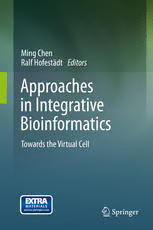Table Of ContentMing Chen
Ralf Hofestädt Editors
Approaches
in Integrative
Bioinformatics
Towards the Virtual Cell
Approaches in Integrative Bioinformatics
Ming Chen • Ralf Hofesta¨dt
Editors
Approaches in Integrative
Bioinformatics
Towards the Virtual Cell
123
Editors
MingChen RalfHofesta¨dt
CollegeofLifeSciences DepartmentofBioinformatics
ZhejiangUniversity andMedicalInformatics
Hangzhou BielefeldUniversity
People’sRepublicofChina Bielefeld,Germany
Additionalmaterialtothisbookcanbedownloadedfromhttp://extras.springer.com
ISBN978-3-642-41280-6 ISBN978-3-642-41281-3(eBook)
DOI10.1007/978-3-642-41281-3
SpringerHeidelbergNewYorkDordrechtLondon
LibraryofCongressControlNumber:2013956814
©Springer-VerlagBerlinHeidelberg2014
Thisworkissubjecttocopyright.AllrightsarereservedbythePublisher,whetherthewholeorpartof
thematerialisconcerned,specificallytherightsoftranslation,reprinting,reuseofillustrations,recitation,
broadcasting,reproductiononmicrofilmsorinanyotherphysicalway,andtransmissionorinformation
storageandretrieval,electronicadaptation,computersoftware,orbysimilarordissimilarmethodology
nowknownorhereafterdeveloped.Exemptedfromthislegalreservationarebriefexcerptsinconnection
with reviews or scholarly analysis or material supplied specifically for the purpose of being entered
and executed on a computer system, for exclusive use by the purchaser of the work. Duplication of
this publication or parts thereof is permitted only under the provisions of the Copyright Law of the
Publisher’slocation,initscurrentversion,andpermissionforusemustalwaysbeobtainedfromSpringer.
PermissionsforusemaybeobtainedthroughRightsLinkattheCopyrightClearanceCenter.Violations
areliabletoprosecutionundertherespectiveCopyrightLaw.
Theuseofgeneraldescriptivenames,registerednames,trademarks,servicemarks,etc.inthispublication
doesnotimply,evenintheabsenceofaspecificstatement,thatsuchnamesareexemptfromtherelevant
protectivelawsandregulationsandthereforefreeforgeneraluse.
While the advice and information in this book are believed to be true and accurate at the date of
publication,neithertheauthorsnortheeditorsnorthepublishercanacceptanylegalresponsibilityfor
anyerrorsoromissionsthatmaybemade.Thepublishermakesnowarranty,expressorimplied,with
respecttothematerialcontainedherein.
Printedonacid-freepaper
SpringerispartofSpringerScience+BusinessMedia(www.springer.com)
Preface
Theunprecedentedaccumulationofhigh-throughputdatafromgenomics,transcrip-
tomics, proteomics, metabolomics, phenomics, etc., has resulted not only in new
attemptstoanswertraditionalbiologicalquestionsandsolvelongstandingissuesin
biology but also in the formulation of novel hypotheses that arise precisely from
this wealth of data. At the present, with thousands of biological data resources
andinformationsystemsinsidetheInternet,anunknownnumberofanalysistools,
and exponential growths of molecular data (especially high-throughputdata), the
storage,processing,description,transmission,connection,andintegrativeanalysis
of this data becomesa greatchallenge for bioinformatics.Thus, the so-called Big
Data becomes the new keyword describing the actual situation for which new
softwaretoolsareneededtoanalyzethisexponentiallyincreasingdata.
Importantapplicationsof Big Data are systems biologyand systemsmedicine.
For instance, hospital information systems represent complex patient data. The
diagnosis process is now supported by new methods of biotechnology using, for
example, high-throughput sequencing approaches. Therefore, we have complex
patient data inside the hospital information system which needs to be stored,
transported,andanalyzed.Newsoftwaretoolsareneededtoallowtheuser-specific
dataaccessandanalysisofthisdata.Overall,todevelopandimplementnewtools
for automatic data integration and analysis will help implement better diagnostic
methods in practice. In the future, the entire genomes of patients will be stored
withinhospitalinformationsystems.Furthermore,itwillbenecessarytosharethe
genome sequences inside the hospital computer network and analyze the genome
data to detect, for example, cancer genes. With the availability of Internet, the
automaticintegrationandanalysis of data are of the most relevantresearchtopics
incomputerscience.Inbiology,suchtoolshavebecomemoreandmoreimportant.
Methodslikehigh-throughputsequencingandomicsanalysisareresponsibleforthe
exponentialdatagenerationprocess.
This book will focus on the integration and analysis of omics data. The
Introductionwillpresentrelevantbiologicalbackgroundandan overviewof these
actual methods. When the Internet merged, methods such as data fusion and
federated database systems became relevant. The initial tools were implemented
v
vi Preface
andgavebirthtoanewfieldofresearch:IntegrativeBioinformatics,whichstrivesto
implementuser-specificintegrationandanalysisofcomplexdata.TheIntroduction
of this bookwill givea definitionand overviewof this pertinentfield of research.
Since then, complex information systems have been developed and implemented.
Finally, the data warehouse concept became more relevant. Today the data ware-
house concept is still the best construction for the implementation of integrative
information systems. The Information Fusion and Retrieval section will focus on
the said data warehouse concept. Furthermore, this part of the book will give an
overview of information retrieval and data mining tools, which allow the user-
specificidentificationandintegrationofdata.Basedonthemethodsdescribedhere,
weareabletoimplementuser-specificintegrationtools.Theanalysisofthisdatacan
bedoneusingstatistic,visualization,oranimationtools.Furthermore,modelingand
simulation are importantanalysis methods. The Network Visualization, Modeling,
and Analysis section will focus on methods for network prediction, network
modeling,andsimulation.Inthecaseofnetworksimulation,wepreferthePetrinet
method,whichallowstheparallelsimulationofcomplexmetabolicpathways.Our
applicationsectionisdividedintotwoparts.First,wefocusonmethodsofBioData
Mapping. One interesting aspect is the possibility of molecular disease mapping
whichallowsthepathwaypredictionofanydiseaseandthesemiautomaticmapping
of this pathway into a virtual 3D cell. The genotype-phenotype map enables us
touncoverthecasualnetworksinsidethe“blackbox”thatliesbetweengenotypes
andphenotypeswithadvancesinhigh-throughputandhigh-dimensionalgenotyping
andphenotypingtechnologies.Anotherimportantandactualtopic ispresentedby
theBiocomputionsection.Afterthereconstructionofabiologicaldiseasenetwork,
theidentificationofbiomarkersorhubsforfurtheranalysisisimportant.Torealize
suchtasks,theimplementationofparallelalgorithmsisfundamental.
Importantresearch topics for the nextfew years will be Big Data and Systems
Medicine.IntegrativeBioinformaticswillbefundamentalindevelopmentsforboth
fieldsandthisbookattemptstopresentanoverviewofrelevantandactualresearch
activities.
We are very grateful to all the authors for sharing their time, wisdom, and
expertise. Finally, we want to thank Ms. Na Xu, the editor of Springer Beijing
Office,forhercontinuousadvice.
Hangzhou,People’sRepublicofChina MingChen
Bielefeld,Germany RalfHofesta¨dt
June2013
Contents
PartI Introduction
1 IntegrativeBioinformatics................................................. 3
MingChenandRalfHofesta¨dt
2 AnOverviewofGeneRegulation......................................... 21
AndrewHarrisonandHughShanahan
PartII InformationFusionandRetrieval
3 InformationRetrievalinLifeSciences:AProgrammaticSurvey..... 73
Matthias Lange, Ron Henkel, Wolfgang Mu¨ller,
DagmarWaltemath,andStephanWeise
4 DataWarehousesinBioinformatics...................................... 111
BenjaminKormeier
5 MolecularInformationFusioninOndex ................................ 131
JanTaubertandJacobKo¨hler
6 TextMiningonPubMed................................................... 161
TimofeyV.Ivanisenko, PavelS.Demenkov,
andVladimirA.Ivanisenko
PartIII NetworkVisualization,ModelingandAnalysis
7 NetworkVisualizationforIntegrativeBioinformatics.................. 173
AndreasKerrenandFalkSchreiber
8 BiologicalNetworkModelingandAnalysis.............................. 203
Sebastian Jan Janowski, Barbara Kaltschmidt,
andChristianKaltschmidt
vii
viii Contents
9 PetriNets for Modeling and Analyzing Biochemical
ReactionNetworks ......................................................... 245
FeiLiuandMonikaHeiner
PartIV BioDataMapping
10 NetworkAnalysisandIntegrationinaVirtualCellEnvironment.... 275
Bjo¨rnSommer
11 BridgingGenomicsandPhenomics ...................................... 299
DijunChen, MingChen, ThomasAltmann,
andChristianKlukas
PartV Biocompution
12 ParallelComputingforGeneNetworksReverseEngineering ........ 337
JaroslawZola
13 ComputationalBiomarkerDiscovery .................................... 355
FanZhang,XiaogangWu,andJakeY.Chen
Part I
Introduction

